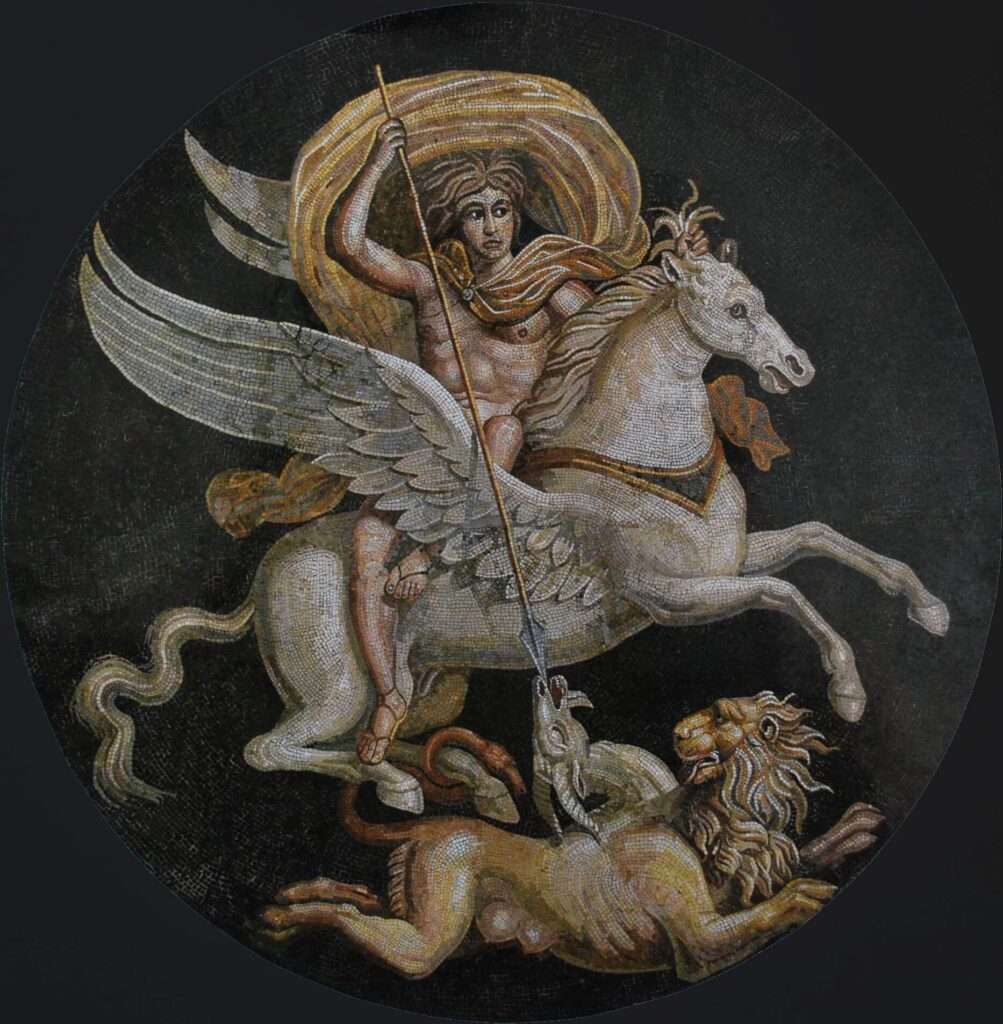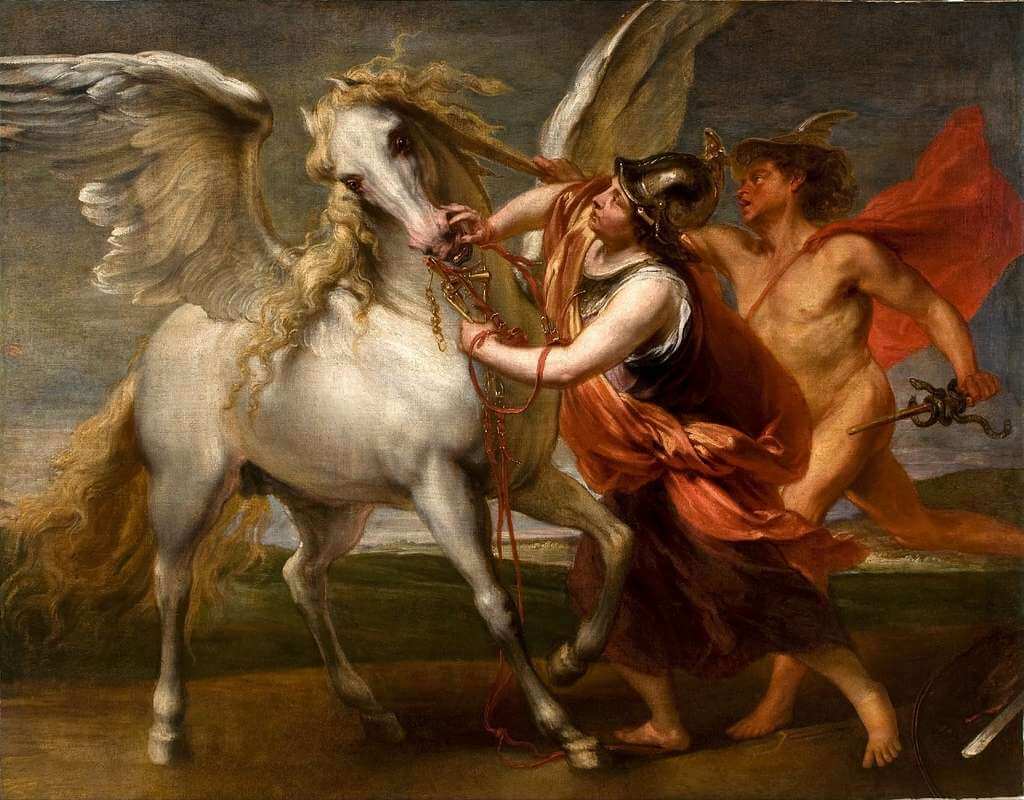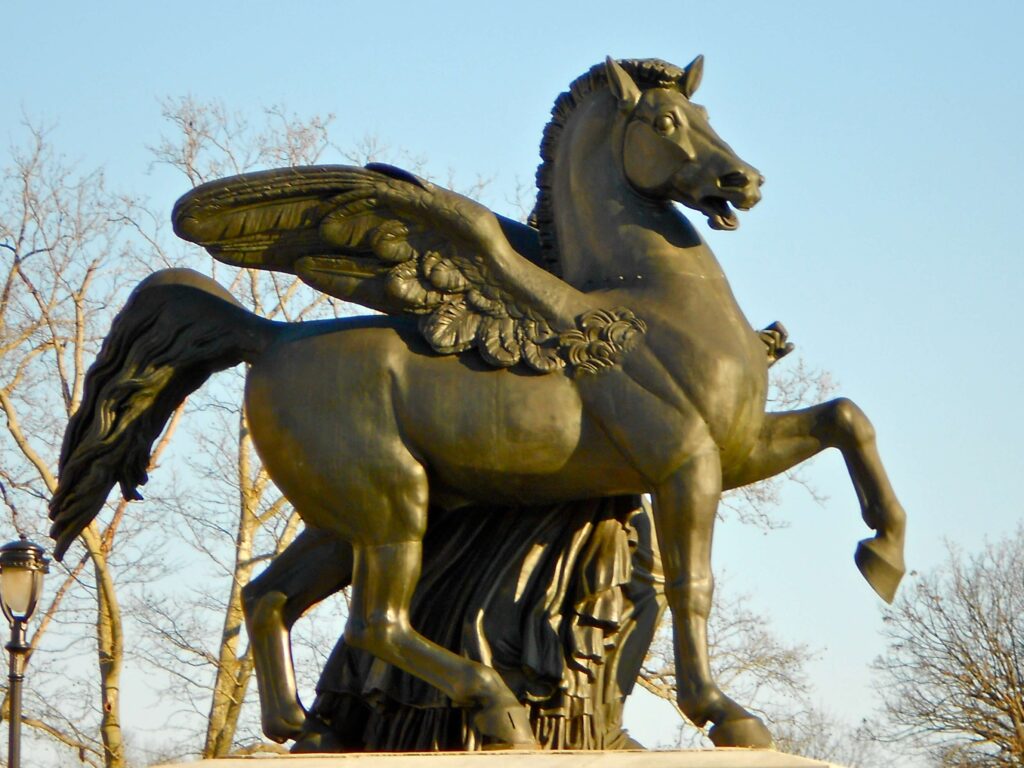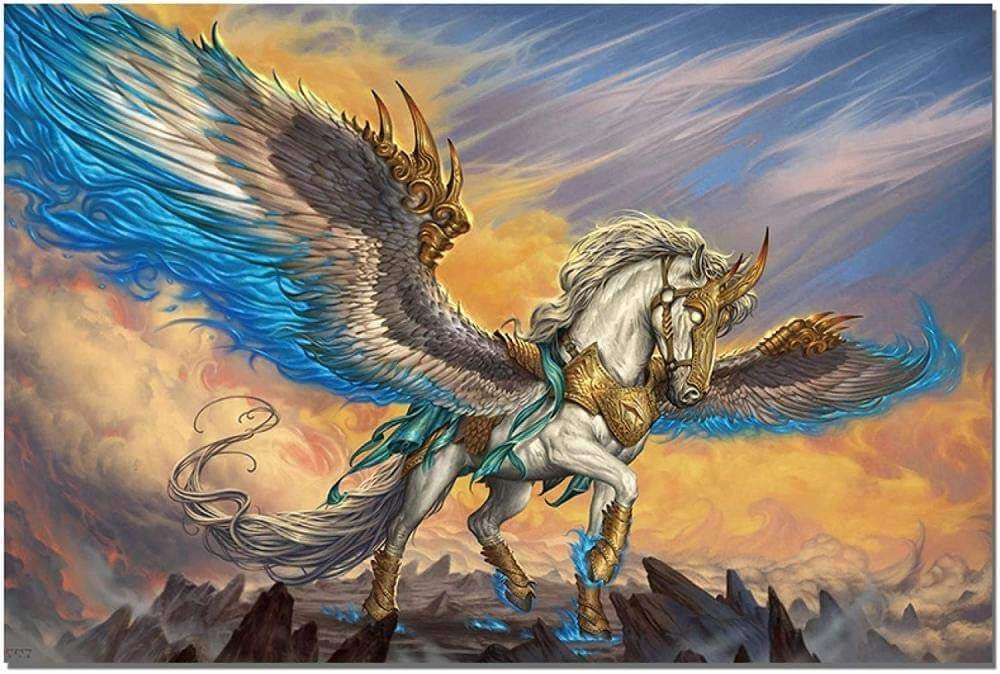Pegasus, a magnificent winged horse from Greek mythology, has captivated human imagination for centuries. Born from the union of the sea god Poseidon and the Gorgon Medusa, Pegasus sprang forth from Medusa’s neck after her encounter with the hero Perseus. This mythical creature’s significance extends far beyond its fantastical birth. Pegasus played pivotal roles in several Greek myths, most notably aiding the hero Bellerophon in defeating the monstrous Chimera. Beyond these tales, Pegasus’ representation of freedom, inspiration, and the soaring spirit of adventure has left a lasting cultural impact. His image adorns ancient artifacts and modern emblems alike, symbolizing everything from poetic inspiration to spiritual ascent. Pegasus remains a powerful emblem in our collective psyche, bridging ancient myths with contemporary culture.
| Origin | Greek Mythology |
| Classification | Mythical Creature |
| Appearance | A winged horse with white, radiant plumage |
| Abilities | Known for its ability to fly, often associated with poetic inspiration |
| Mythological Role | Born from the blood of the Gorgon Medusa after her beheading; tamed by Bellerophon |
| Significance | Symbol of poetic inspiration, divine horse, and hero’s companion |
| Cultural Impact | A prominent figure in Greek mythology and often depicted in art and literature |
1. The Birth and Origins of Pegasus
The Miraculous Birth
Hesiod’s “Theogony” tells us that Perseus slew Medusa, the Gorgon, and Pegasus was born from her blood. Athena had transformed Medusa, once a beautiful maiden, into a monstrous creature. When Perseus beheaded Medusa, Pegasus emerged, fully grown, from her severed neck. This remarkable birth, combining elements of horror and marvel, highlights the duality of life and death in Greek mythology.
Divine Parentage: Poseidon and Medusa
Pegasus is often recognized as the offspring of Poseidon, the god of the sea, and Medusa. This union between a divine figure and a mortal-turned-monster is symbolic of the mingling of the celestial and the earthly. Poseidon’s influence is evident in Pegasus’ mastery over water, which includes the ability to create springs with a stomp of his hoof. The parentage of Pegasus serves as a metaphor for the coexistence of beauty and terror, showcasing the complexity of Greek mythological characters.
Symbolism of Pegasus’ Origins
The origins of Pegasus are not just a story of birth but also a rich tapestry of symbolism. In Greek culture, horses were often seen as symbols of strength, freedom, and nobility, traits that are embodied in Pegasus. The extraordinary circumstances of his birth from Medusa – a blend of beauty and terror – underscore the Greek belief in the transformative power of the gods and the fluid boundaries between different states of being. Pegasus’ emergence from Medusa’s blood also signifies the theme of life emerging from death, a common motif in ancient mythologies that speaks to the eternal cycle of destruction and creation.

2. Pegasus in Greek Myths
Pegasus and Bellerophon: The Battle Against Chimera
One of the most celebrated tales of Pegasus is his partnership with the hero Bellerophon. According to mythology, Bellerophon, with the help of Athena, tamed Pegasus at the well of Pirene. The duo became inseparable, and their most famous adventure was the battle against Chimera, a fire-breathing monster with a lion’s head, a goat’s body, and a serpent’s tail. Pegasus’ ability to fly gave Bellerophon a significant advantage, allowing him to attack from the air. This story, chronicled in texts like Homer’s “Iliad,” highlights the bond between hero and mythical creature and illustrates the theme of conquering seemingly insurmountable challenges with divine assistance.
Symbolic Meanings in the Bellerophon Myth
In this narrative, Pegasus symbolizes more than just physical strength and freedom; he represents divine favor and the power of wisdom over brute force. The successful defeat of Chimera by Bellerophon, aided by Pegasus, underscores the importance of intelligence, courage, and divine support in overcoming obstacles. Pegasus serves as a bridge between the gods and humans, highlighting the potential of human beings to achieve greatness with the aid of the divine.

Other Myths Featuring Pegasus
Beyond the Bellerophon saga, Pegasus appears in various other Greek myths. His role in creating the Hippocrene, the fountain of the Muses on Mount Helicon, by striking his hoof to the ground, cements his association with poetic inspiration and the arts. This act links Pegasus to the realm of creativity, suggesting that inspiration often springs forth from unexpected sources.
The Enduring Symbolism of Pegasus
Throughout these myths, Pegasus remains a symbol of purity, creativity, and the aspiration for higher knowledge. His flight represents the journey of the soul and the quest for immortality, a theme prevalent in many Greek myths. The enduring allure of Pegasus in these stories lies in his representation of the boundless possibilities of the human spirit, coupled with the grace and majesty of the divine.
3. Symbolism and Significance of Pegasus
Emblem of Inspiration and Creativity
Pegasus, in Greek culture, extends far beyond his physical depiction as a winged horse. He is predominantly seen as a symbol of divine inspiration, particularly in the arts and poetry. The creation of the Hippocrene, the Muses’ fountain, by Pegasus, solidified this association. Poets and artists throughout history have invoked his image as a metaphor for the soaring flight of creativity and the sudden burst of inspiration that leads to artistic creation.
Representation of Freedom and Aspiration
The image of Pegasus flying freely in the skies resonates deeply with the human desire for freedom and the aspiration to reach higher realms of existence. In Greek mythology, the ability to fly was often reserved for gods and select heroes, making Pegasus a bridge between the mortal world and the divine. This aspect of Pegasus symbolizes transcendence, the overcoming of earthly bounds, and the pursuit of higher knowledge and spiritual enlightenment.

Pegasus Through the Centuries
Over the centuries, the perception of Pegasus has evolved, yet his core symbolism remains intact. In the Middle Ages, Pegasus was often seen as a symbol of wisdom and fame, representing the loftiness of the spirit. During the Renaissance, he was revered as a symbol of poetic imagination and creativity. In modern times, Pegasus continues to be a popular figure in art, literature, and even corporate logos, often used to symbolize speed, power, and unfettered imagination.
Pegasus: A Multifaceted Symbol
The multifaceted symbolism of Pegasus reflects the complexity of Greek mythology itself. Pegasus is not just a creature of myth but a representation of the human psyche’s diverse aspects – creativity, aspiration, freedom, and the journey towards understanding the divine. His enduring appeal lies in this rich tapestry of meanings, making him a timeless emblem in both ancient and modern contexts.
4. Pegasus in Art and Literature
Ancient Artistic Depictions
Pegasus has been a prominent figure in art since antiquity. In ancient Greek art, he is often depicted as a majestic, winged horse, symbolizing both power and grace. One notable example is the Pegasus of Olympia, a statue that once stood at the temple of Zeus in Olympia, exemplifying the reverence of Pegasus in Greek culture. Ancient coins, like those from Corinth, frequently featured Pegasus, indicating his importance and recognition in the Greek world.

Renaissance and Beyond
During the Renaissance, Pegasus’ imagery underwent a revival, symbolizing the heights of poetic inspiration and human imagination. He was featured in works by artists like Leonardo da Vinci, who used Pegasus to represent the aspiring soul. In Botticelli’s “Pallas and the Centaur,” Pegasus is a symbol of wisdom triumphing over brutishness, echoing the Renaissance’s humanistic values.
Pegasus in Literature
In literature, Pegasus has been a symbol of poetic inspiration since the times of the ancient Greeks. He is prominently featured in Greek epics and tragedies, like Euripides’ play “Hippolytus,” where his mythic qualities are celebrated. Fast forward to the 19th and 20th centuries, poets like Yeats used Pegasus as a metaphor for poetic inspiration in their works. Pegasus’ image as a source of inspiration continues in contemporary literature, where he often symbolizes the unfettered realm of imagination and creativity.
Modern Interpretations
In modern art, artists have adapted Pegasus’ image to various artistic styles and movements, often using it in symbolic and allegorical contexts to represent themes ranging from freedom and purity to the power of nature and the human spirit. Art historians note that Pegasus’ enduring appeal in art lies in his versatility as a symbol and his ability to adapt to changing cultural and artistic paradigms.
Pegasus: A Universal Symbol in Art and Literature
Throughout history, Pegasus has transcended his mythological origins to become a universal symbol in both art and literature. His representation has evolved, yet his core attributes—inspiration, freedom, and the pursuit of higher knowledge—remain constant. This adaptability makes Pegasus a timeless figure, resonating with audiences across various epochs and artistic genres.
5. Pegasus’ Legacy Today
Pegasus in Modern Media and Brands
The image of Pegasus has seamlessly transitioned into the modern era, becoming a symbol in various media and commercial brands. Its representation of speed, strength, and inspiration makes it an appealing emblem for companies, especially in the automotive and aviation industries. For instance, Pegasus is the namesake and logo of several airlines, symbolizing the grace and power of flight. In the automotive sector, the Pegasus symbol has been associated with speed and elegance.

Pegasus in Film and Television
In movies and television, Pegasus often appears in works that delve into fantasy and mythology. His portrayal ranges from the faithful reimagining of mythological stories to creative adaptations in modern settings. Notable examples include the “Clash of the Titans” series, where Pegasus plays a significant role as a companion to the hero. Animated films and series also frequently feature Pegasus, appealing to younger audiences with his majestic and fantastical nature.

Literature and Popular Culture
In contemporary literature, Pegasus continues to inspire authors, featuring in fantasy novels and children’s books. He often appears as a character that embodies freedom and exploration, appealing to the universal human desire for adventure. His mythological background provides a rich tapestry for storytelling, enabling authors to explore themes of heroism, fantasy, and the struggle between good and evil.
Artistic Depictions in the Modern Era
Modern artists utilize Pegasus’ imagery in various forms, from traditional paintings to digital art, reinterpreting his symbolic meaning to reflect current societal themes, such as the quest for freedom in an increasingly complex world. Cities around the world feature public sculptures and installations of Pegasus, often using them as symbols of hope, inspiration, and the enduring power of myth.
The Timeless Appeal of Pegasus
Pegasus’ legacy in today’s world underscores the timeless appeal of mythology and its capacity to inspire across ages and cultures. His enduring presence in various facets of modern life—from art and literature to media and commercial brands—reflects the continuous fascination and relevance of ancient myths in contemporary society. Pegasus remains a powerful symbol, bridging the ancient past with the present, and continuing to inspire imagination and creativity in diverse realms.
6. Conclusion
The enduring legacy of Pegasus, the winged horse of Greek mythology, extends far beyond ancient tales and artistic depictions. As a symbol of inspiration, freedom, and the aspiration for higher realms, Pegasus continues to captivate and inspire in modern culture, art, literature, and media. His story, evolving through centuries, highlights the vital role mythical creatures play in our understanding of cultural and historical contexts. Pegasus stands not merely as a character from Greek mythology but as a timeless emblem, reflecting humanity’s deepest aspirations and the universal pursuit of transcendence and creativity. His relevance in various contemporary forms underscores the power of myth to endure, adapt, and continue to hold significance across ages, reminding us of the rich tapestry of human imagination and the enduring nature of our cultural heritage.
